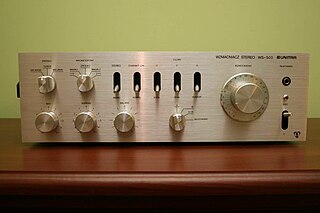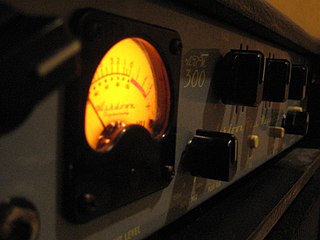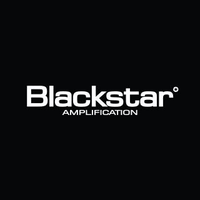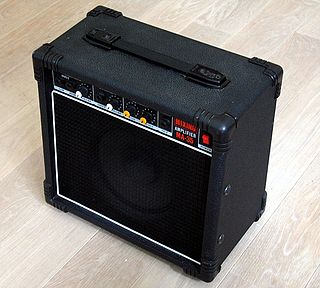
An audio power amplifier is an electronic amplifier that amplifies low-power electronic audio signals, such as the signal from a radio receiver or an electric guitar pickup, to a level that is high enough for driving loudspeakers or headphones. Audio power amplifiers are found in all manner of sound systems including sound reinforcement, public address, home audio systems and musical instrument amplifiers like guitar amplifiers. It is the final electronic stage in a typical audio playback chain before the signal is sent to the loudspeakers.

Vox is a British musical equipment manufacturer founded in 1957 by Thomas Walter Jennings in Dartford, Kent, England. The company is most famous for making the Vox AC30 guitar amplifier, used by The Beatles, The Rolling Stones, The Kinks, The Yardbirds, Queen, Dire Straits, U2, and Radiohead; the Vox Continental electric organ, the Vox wah-wah pedal used by Jimi Hendrix, and a series of innovative electric guitars and bass guitars. Since 1992, Vox has been owned by the Japanese electronics firm Korg.

An instrument amplifier is an electronic device that converts the often barely audible or purely electronic signal of a musical instrument into a larger electronic signal to feed to a loudspeaker. An instrument amplifier is used with musical instruments such as an electric guitar, an electric bass, electric organ, electric piano, synthesizers and drum machine to convert the signal from the pickup or other sound source into an electronic signal that has enough power, due to being routed through a power amplifier, capable of driving one or more loudspeaker that can be heard by the performers and audience.

A guitar amplifier is an electronic device or system that strengthens the electrical signal from a pickup on an electric guitar, bass guitar, or acoustic guitar so that it can produce sound through one or more loudspeakers, which are typically housed in a wooden cabinet. A guitar amplifier may be a standalone wood or metal cabinet that contains only the power amplifier circuits, requiring the use of a separate speaker cabinet–or it may be a "combo" amplifier, which contains both the amplifier and one or more speakers in a wooden cabinet. There is a wide range of sizes and power ratings for guitar amplifiers, from small, lightweight "practice amplifiers" with a single 6-inch speaker and a 10-watt amp to heavy combo amps with four 10-inch or four 12-inch speakers and a 100-watt amplifier, which are loud enough to use in a nightclub or bar performance.

Peavey Electronics Corporation is an American company which designs, develops, manufactures and markets professional audio equipment. It is one of the largest audio equipment manufacturers in the world, and is headquartered in Meridian, Mississippi.
Orange Music Electronic Company is an English amplifier manufacturing company, noted for their products' distinctive sound and the bright orange Tolex-like covering of their heads and speaker cabinets. The company was founded in 1968 by Cliff Cooper, who decided to build his own amplifiers when vendors refused to supply his West End musical instrument store, Orange Store, due to Cooper's youth and countercultural image. The brand's early amps were adopted by Peter Green of Fleetwood Mac and were used on Stevie Wonder's Superstition, which brought Orange worldwide recognition. The brand's "Pics Only" models—nicknamed for their use of symbols rather than text on their control panels—were released in the early 1970s to much success and established a signature "Orange sound." However, large-scale production of Orange Amps ceased in 1978 and Cooper spent the '80s building and selling amps in limited numbers. After a line of reissue models licensed by Gibson in the early '90s proved unsuccessful, Cooper regained control of the brand and found new success with the 1998 release of the AD30, with notable fans like Jimmy Page. In 2003, Orange released the Rockerverb series, which has become a favorite amp among heavy metal guitarists.

A pickup is a transducer that captures or senses mechanical vibrations produced by musical instruments, particularly stringed instruments such as the electric guitar, and converts these to an electrical signal that is amplified using an instrument amplifier to produce musical sounds through a loudspeaker in a speaker enclosure. The signal from a pickup can also be recorded directly.

Marshall is a British company that designs and manufactures music amplifiers, speaker cabinets, brands personal headphones and earphones, drums and bongos. The company also owns a record label called Marshall Records. It was founded in London by drum shop owner and drummer, Jim Marshall, and is now based in Bletchley, Milton Keynes, England.

Scholz Research & Development, Inc. was the name of the company founded by musician and engineer Tom Scholz to design and manufacture music technology products.

Ashdown Engineering is a British manufacturer of instrument amplifiers, particularly for bass and acoustic guitars.

A bass amplifier is a musical instrument electronic device that uses electrical power to make lower-pitched instruments such as the bass guitar or double bass loud enough to be heard by the performers and audience. Bass amps typically consist of a preamplifier, tone controls, a power amplifier and one or more loudspeakers ("drivers") in a cabinet.

Distortion and overdrive are forms of audio signal processing used to alter the sound of amplified electric musical instruments, usually by increasing their gain, producing a "fuzzy", "growling", or "gritty" tone. Distortion is most commonly used with the electric guitar, but may also be used with other electric instruments such as electric bass, electric piano, synthesizer and Hammond organ. Guitarists playing electric blues originally obtained an overdriven sound by turning up their vacuum tube-powered guitar amplifiers to high volumes, which caused the signal to distort. While overdriven tube amps are still used to obtain overdrive, especially in genres like blues and rockabilly, a number of other ways to produce distortion have been developed since the 1960s, such as distortion effect pedals. The growling tone of a distorted electric guitar is a key part of many genres, including blues and many rock music genres, notably hard rock, punk rock, hardcore punk, acid rock, and heavy metal music, while the use of distorted bass has been essential in a genre of hip hop music and alternative hip hop known as "SoundCloud rap".

A guitar speaker is a loudspeaker – specifically the driver (transducer) part – designed for use in a combination guitar amplifier of an electric guitar, or for use in a guitar speaker cabinet. Typically these drivers produce only the frequency range relevant to electric guitars, which is similar to a regular woofer type driver, which is approximately 75 Hz — 5 kHz, or for electric bass speakers, down to 41 Hz for regular four-string basses or down to about 30 Hz for five-string instruments.

Eden Amplification began as an American bass amplification company in 1976. The company takes its name from Eden Prairie, Minnesota, where the idea for the company was conceived. Eden designs and manufactures high-end bass amplification systems. This includes bass amplifiers, pre-amplifiers, power amps, bass pedals, and bass cabinets. Its most famous series of products include World Tour Amplifiers and D-series Cabinets. Eden's reputation was founded on the fact that everything was designed and built "in-house", including the speakers.
The Peavey 5150 is a vacuum tube based guitar amplifier made by Peavey Electronics from 1992 on. The amplifier was initially created as a signature model for Eddie Van Halen. After Van Halen and Peavey parted ways in 2004, the name was changed to Peavey 6505 in celebration of Peavey's 40th anniversary (1965–2005). The 5150 name was used again by Van Halen in partnership with Fender under the EVH brand.

Blackstar Amplification is a British company that produces and manufacturers guitar amplifiers and effects units. The company was founded by a group of ex-Marshall employees, most notably Bruce Keir, who became technical Director at Blackstar, and former Chief Design Engineer at Marshall, Ian Robinson. In 2009 the company began operations in the United States. The majority of the research and development for Blackstar is carried out in the UK. Blackstar is endorsed by major artists like Ozzy Osbourne, Kurt Viehdorfer, Neal Schon, Opeth, Richie Sambora of Bon Jovi. Blackstar has been consistently ranked amongst the best amplification brands by leading guitarists. Bruce Keir died in September 2021 at the age of 60.

Traynor is a brand of bass amplifiers and guitar amplifiers, the first brand formed by Yorkville Sound. The Traynor brand, named for founder Peter Traynor, began in 1963 with the Dynabass bass amplifier, a rental product. Traynor first became popular in Canada by providing less expensive versions of the circuits used in Marshall and Fender amplifiers of the time. The revived brand now produces a wide range of electric, acoustic, and bass guitar amps.

A keyboard amplifier is a powered electronic amplifier and loudspeaker in a wooden speaker cabinet used for the amplification of electronic keyboard instruments. Keyboard amplifiers are distinct from other types of amplification systems such as guitar amplifiers due to the particular challenges associated with making keyboards sound louder on stage; namely, to provide solid low-frequency sound reproduction for the deep basslines that keyboards can play and crisp high-frequency sound for the high-register notes. Another difference between keyboard amplifiers and guitar/bass amplifiers is that keyboard amps are usually designed with a relatively flat frequency response and low distortion. In contrast, many guitar and bass amp designers purposely make their amplifiers modify the frequency response, typically to "roll-off" very high frequencies, and most rock and blues guitar amps, and since the 1980s and 1990s, even many bass amps are designed to add distortion or overdrive to the instrument tone.

The Peavey Classic 30 112 is a guitar amplifier produced by Peavey Electronics. It is a tube amplifier designed for Blues, Country and Rock musicians. The Classic 30 112 is a member of the Classic Series family of amplifiers. The amps are known for their durability, flexibility, and tone. Earlier models were dressed in black tolex, while more recent models are dressed in a diagonal tweed material.

















